Perception of Translucency and Glossiness: Influence of the Optical Scattering Properties on Sensory Evaluation
Abstract
:1. Introduction
2. Materials
3. Method
3.1. Measurement Method of the Scattering Properties of Scattering Medium
3.2. Constructed System for Visual Perception Test
3.3. Thurston’s Paired Comparison Method
- The distribution of the translucency scale values is given by a normal distribution;
- The variance σ is independent of the size of the scale values (strength of translucency and glossiness) and has a constant value;
- In a pairwise comparison, if the difference in the glossiness or translucency scale values is the same, the strength of these visual perceptions is statistically determined in the same proportion.
3.4. Protocol of the Sensory Test
- Informed consent was obtained from the panelist. No details of the samples to be viewed in the experiment or the definition of visual perception to be evaluated were explained. The panelists were simply informed that they would be asked to answer questions regarding the “glossiness” or “translucency” of the substance to be viewed in Japanese;
- The flow of the sensory test was practiced with each panelist by using a mock sample;
- First, the panelist was asked to close his/her eyes for 5 s and relax. During this time, two samples were set up in the apparatus for pairwise comparisons. This process not only allows the panelist to relax during the sensory test, but also avoids the panelist from seeing the samples in an environment outside of the apparatus;
- The panelist was asked to open his eyes and to observe the sample for 3 s. The time should be short so as to induce the panelist to give an answer, rather than asking the panelist to think for a long period of time before giving an answer;
- After 3 s of observation, the panelist was asked to close his/her eyes and relax for 30 s to diminish previous samples and to focus on the comparison of only the next two samples in the experimental setup;
- Steps 4 and 5 were repeated for 33 times consecutively;
- After completing step 6 following a 5-min break, steps 3 to 6 were repeated to complete the observation of a total of 66 sets of samples. Since a total of 66 sets of samples are conducted at one time, panelists may become too fatigued to concentrate on the sensory test in the latter half of the test, so the test was divided into half sets with a break in between.
3.5. Panelists
4. Results and Discussion
4.1. Scattering Coefficient of Scattering Medium Sumple Changing by Stirring Rate
4.2. Sensory Test for Glossiness and Translucency
5. Conclusions
Author Contributions
Funding
Institutional Review Board Statement
Informed Consent Statement
Data Availability Statement
Conflicts of Interest
References
- Reimann, M.; Zaichkowsky, J.; Neuhaus, C.; Bender, T.; Weber, B. Aesthetic package design: A behavioral, neural, and psychological investigation. J. Consum. Psychol. 2010, 20, 431–441. [Google Scholar] [CrossRef]
- Gjoni, A. Design: Aesthetics as a Promoter of Selling Products in Kosovo. Open J. Bus. Manag. 2021, 9, 1104–1120. [Google Scholar] [CrossRef]
- Terescenco, D.; Hucher, N.; Picard, C.; Savary, G. Sensory perception of textural properties of cosmetic Pickering emulsions. Int. J. Cosmet. Sci. 2020, 42, 198–207. [Google Scholar] [CrossRef] [PubMed]
- Gilbert, L.; Picard, C.; Savary, G.; Grisel, M. Impact of polymers on texture properties of cosmetic emulsions: A methodological approach. J. Sens. Stud. 2012, 27, 392–402. [Google Scholar] [CrossRef]
- Gilbert, L.; Savary, G.; Grisel, M.; Picard, C. Predicting sensory texture properties of cosmetic emulsions by physical measurements. Chemom. Intell. Lab. Syst. 2013, 124, 21–31. [Google Scholar] [CrossRef]
- Timm, K.; Myant, C.; Nuguid, H.; Spikes, H.A.; Grunze, M. Investigation of friction and perceived skin feel after application of suspensions of various cosmetic powders. Int. J. Cosmet. Sci. 2012, 34, 458–465. [Google Scholar] [CrossRef]
- Gore, E.; Picard, C.; Savary, G. Spreading behavior of cosmetic emulsions: Impact of the oil phase. Biotribology 2018, 16, 17–24. [Google Scholar] [CrossRef]
- Gilbert, L.; Picard, C.; Savary, G.; Grisel, M. Rheological and textural characterization of cosmetic emulsions containing natural and synthetic polymers: Relationships between both data. Colloids Surf. A Physicochem. Eng. Asp. 2013, 421, 150–163. [Google Scholar] [CrossRef]
- Gómez, I.; Calvo, F.; Gómez, J.M.; Ricardez-Sandoval, L.; Alvarez, O. A multiscale approach for the integrated design of emulsified cosmetic products. Chem. Eng. Sci. 2022, 251, 117493. [Google Scholar] [CrossRef]
- Gilbert, L.; Loisel, V.; Savary, G.; Grisel, M.; Picard, C. Stretching properties of xanthan, carob, modified guar and celluloses in cosmetic emulsions. Carbohydr. Polym. 2013, 93, 644–650. [Google Scholar] [CrossRef]
- Dubuisson, P.; Picard, C.; Grisel, M.; Savary, G. How does composition influence the texture of cosmetic emulsions? Colloids Surf. A Physicochem. Eng. Asp. 2018, 536, 38–46. [Google Scholar] [CrossRef]
- Venkataramani, D.; Tsulaia, A.; Amin, S. Fundamentals and applications of particle stabilized emulsions in cosmetic formulations. Adv. Colloid Interface Sci. 2020, 283, 102234. [Google Scholar] [CrossRef] [PubMed]
- Calvo, F.; Gómez, J.M.; Ricardez-Sandoval, L.; Alvarez, O. Integrated design of emulsified cosmetic products: A review. Chem. Eng. Res. Des. 2020, 161, 279–303. [Google Scholar] [CrossRef]
- Takahashi, T.; Miyamoto, H.; Kono, T.; Gonome, H.; Yamada, J.; Shundo, A. The optical properties of nanoparticle dispersions prepared by a high speed thin film mixer. J. Soc. Cosmet. Chem. 2017, 51, 142–146. [Google Scholar] [CrossRef]
- Asano, C.; Takahashi, T.; Shundo, A.; Ito, S.; Yonezawa, T. Distinct Improvement in UV Light Protection Properties by TiO2 Dispersion Using a Thin Film Spinning Technique. J. Soc. Cosmet. Chem. 2022, in press.
- Siegel, R.; Howel, J.R. Thermal Radiation Heat Transfer, 3rd ed.; Taylor and Francis: Abingdon, UK, 1992; pp. 480–689. [Google Scholar]
- Özışık, M.N. Radiative Transfer & Interactions with Conduction & Convection; Welbel & Peck: New York, NY, USA, 1985; pp. 249–254. [Google Scholar]
- Boissé, S.; Rieger, J.; Pembouong, G.; Beaunier, P.; Charleux, B. Influence of the stirring speed and CaCl2 concentration on the nano-object morphologies obtained via RAFT-mediated aqueous emulsion polymerization in the presence of a water-soluble macroRAFT agent. J. Polym. Sci. Part A Polym. Chem. 2011, 49, 3346–3354. [Google Scholar] [CrossRef]
- Kono, T.; Yamada, J. Development of measurement instrument for optical properties of human skin in vivo. Jpn. J. Thermophys. Prop. 2017, 31, 72–80. [Google Scholar] [CrossRef]
- Kono, T.; Yamada, J. In vivo measurement of optical properties of human skin for 450–800 nm and 950–1600 nm wavelengths. Int. J. Thermophys. 2019, 40, 51. [Google Scholar] [CrossRef]
- Bohren, C.F.; Huffman, D.R. Absorption and Scattering of Light by Small Particles; Wiley: New York, NY, USA, 1983. [Google Scholar]
- Michels, R.; Foschum, F.; Kienle, A. Optical properties of fat emulsions. Opt. Express 2008, 16, 5907–5925. [Google Scholar] [CrossRef]
- Thurstone, L.L. A law of comparative judgment. Psychol. Rev. 1927, 34, 273–286. [Google Scholar] [CrossRef]
- Indo, T. Thurstone no shinri shakudo kousei-hou. J. Acoust. Soc. Jpn. 1962, 18, 16–22. [Google Scholar]
- Stockman, A.; Sharpe, L.T. The spectral sensitivities of the middle-and long-wavelength-sensitive cones derived from measurements in observers of known genotype. Vis. Res. 2000, 40, 1711–1737. [Google Scholar] [CrossRef] [Green Version]
- McHugh, M.L. The chi-square test of independence. Biochem. Med. 2013, 23, 143–149. [Google Scholar] [CrossRef] [PubMed] [Green Version]
- Yamada, J.; Jin, Y.; Okamoto, S. Study on quantifying feel of translucency for scattering material. Therm. Engine Power Eng. 2015, 81, 15-00218. [Google Scholar]

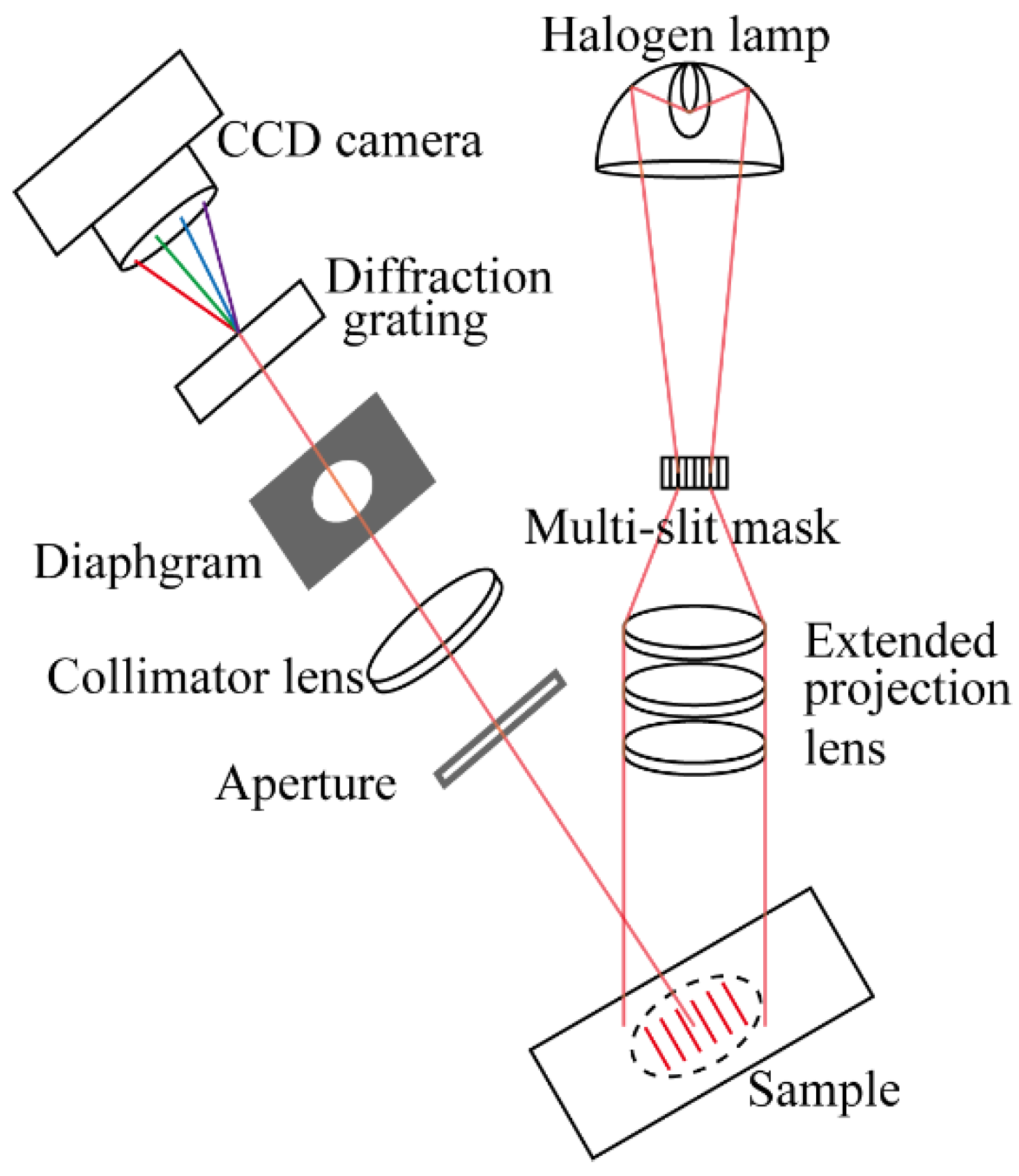

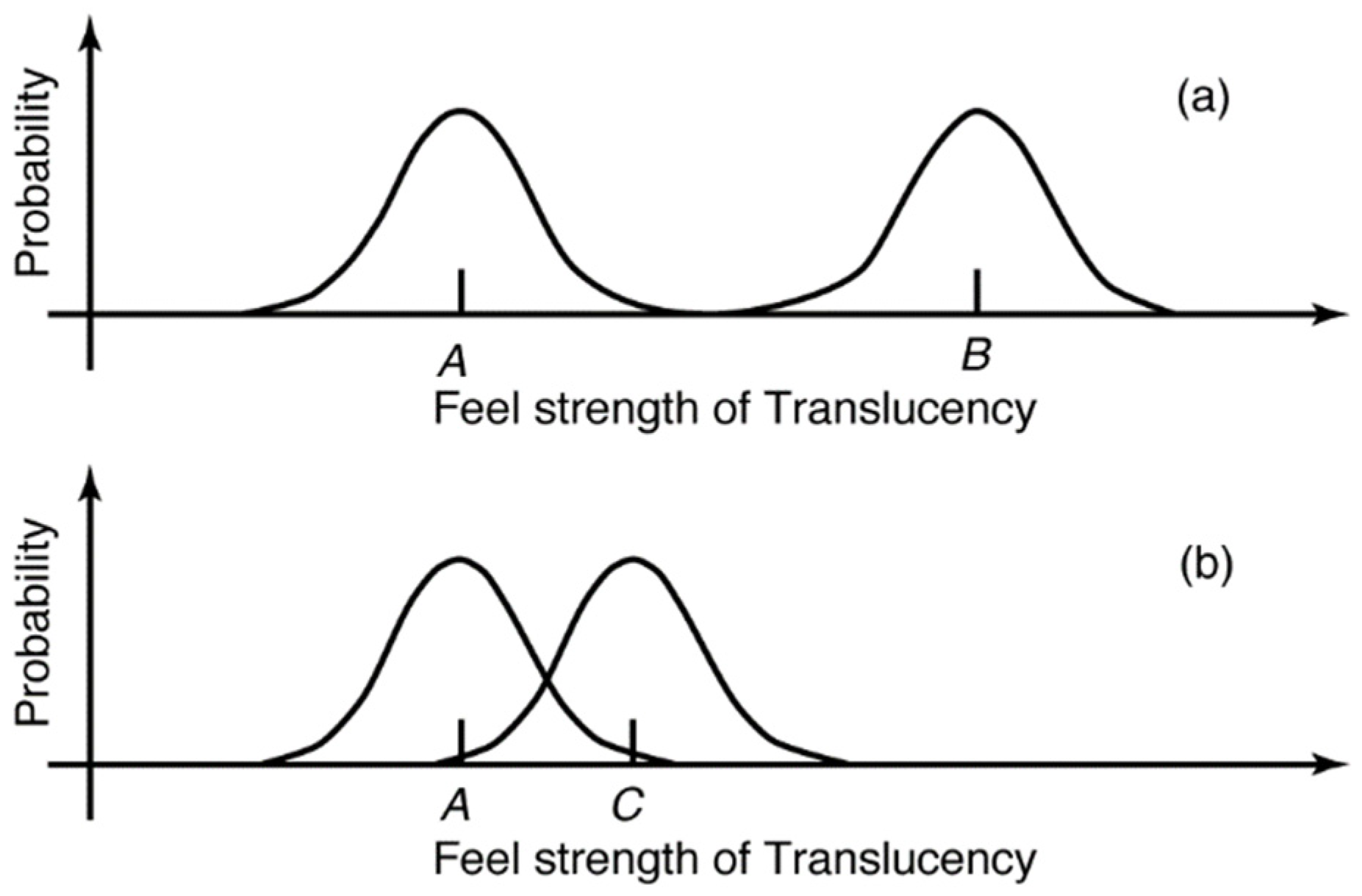
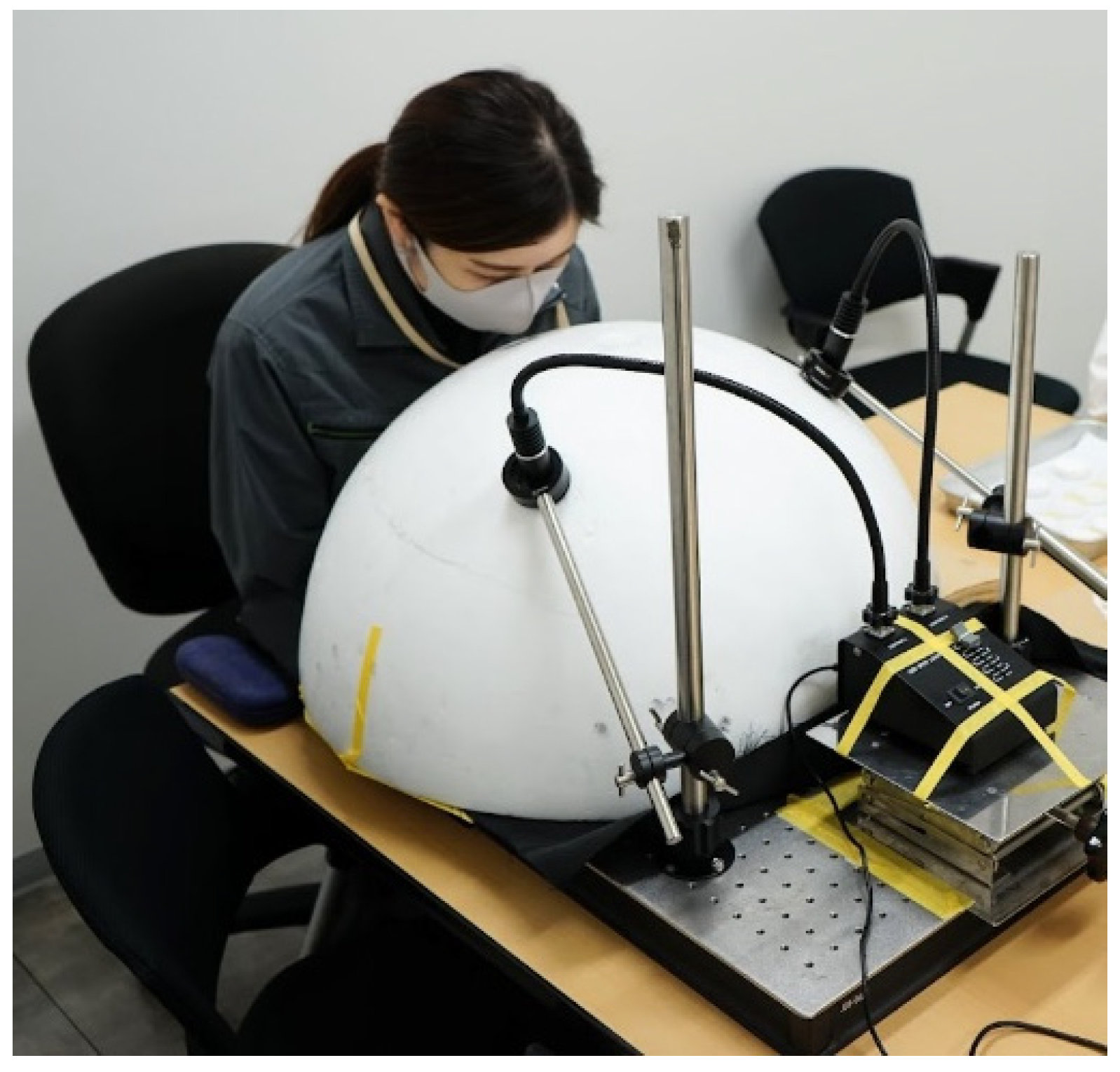
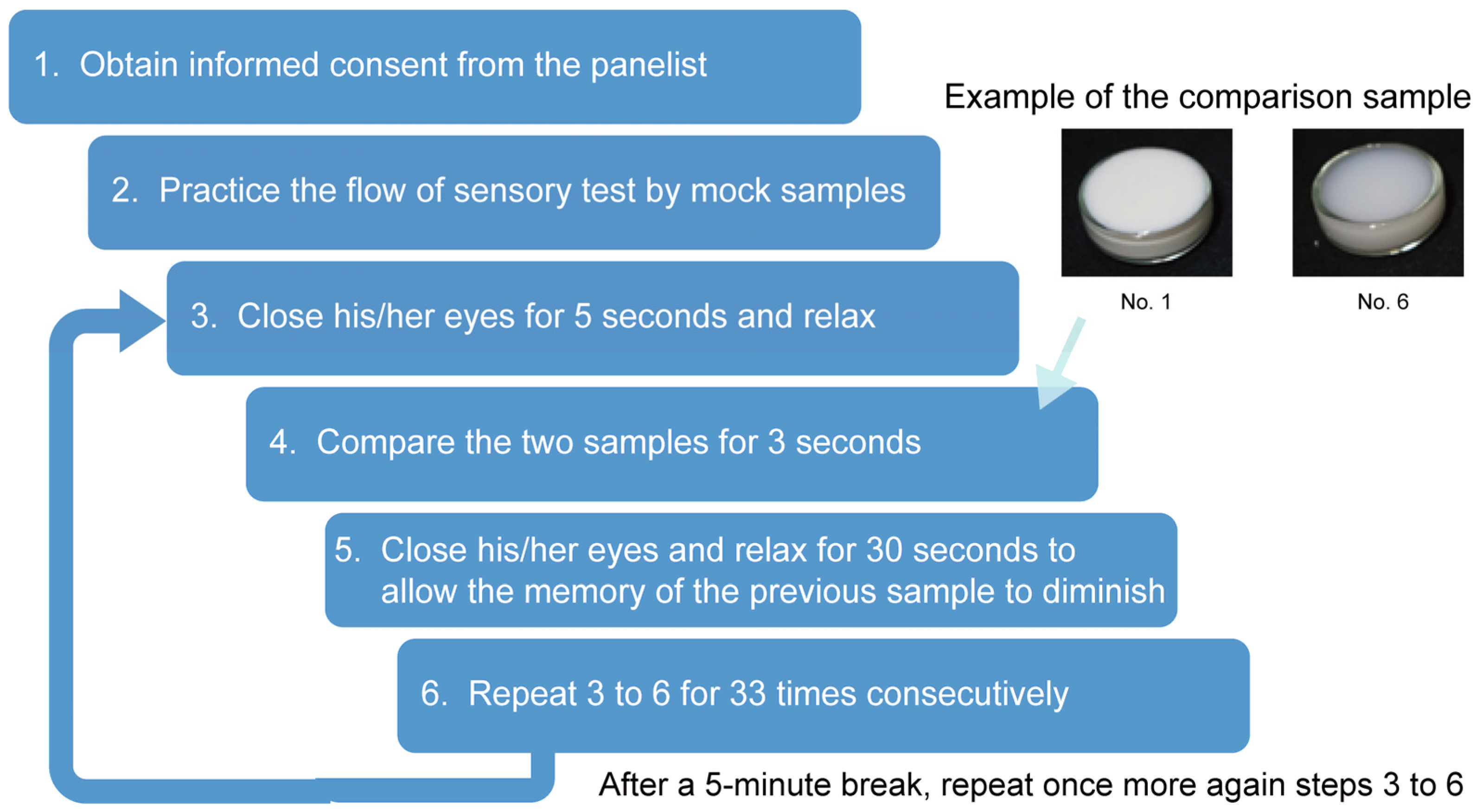
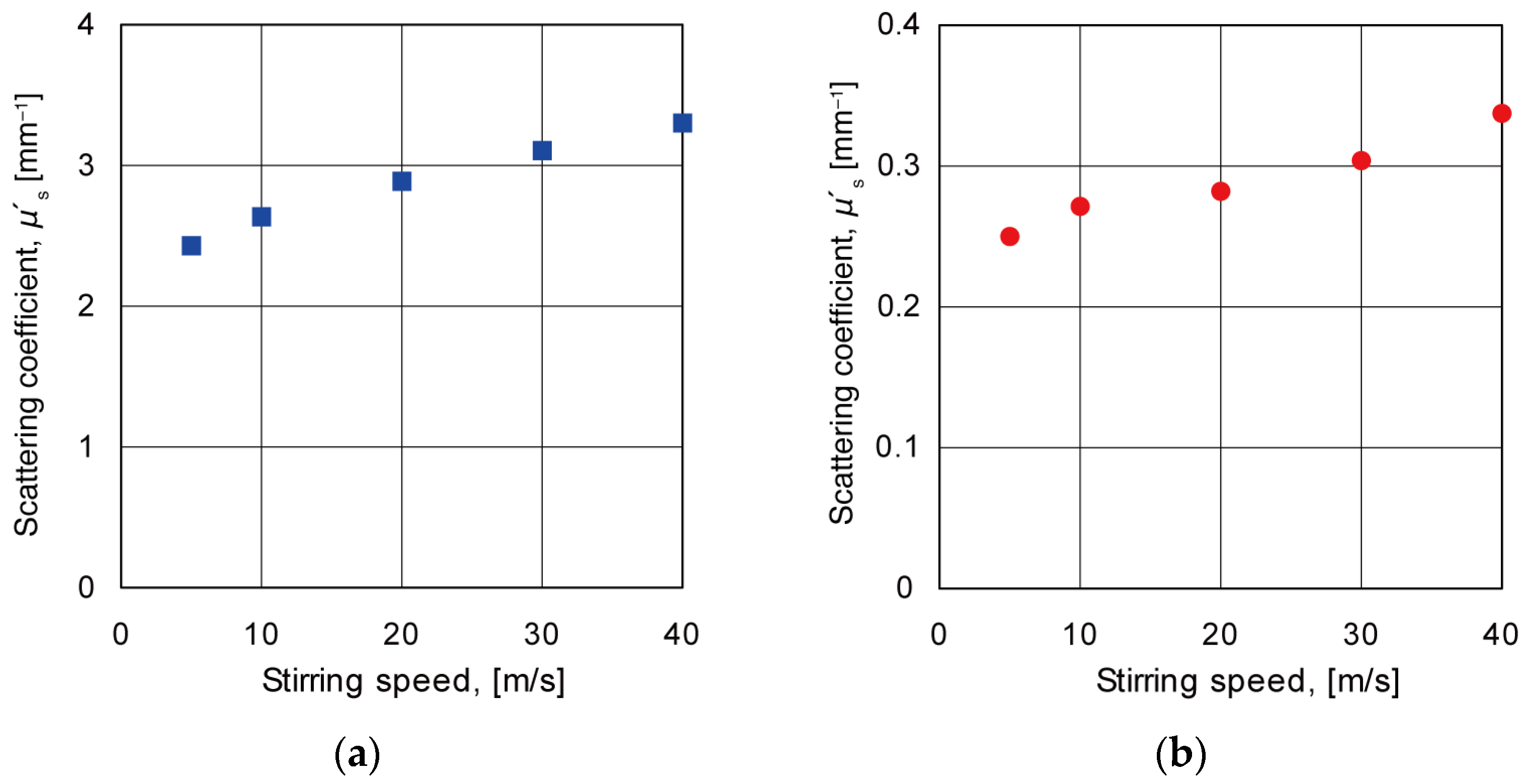
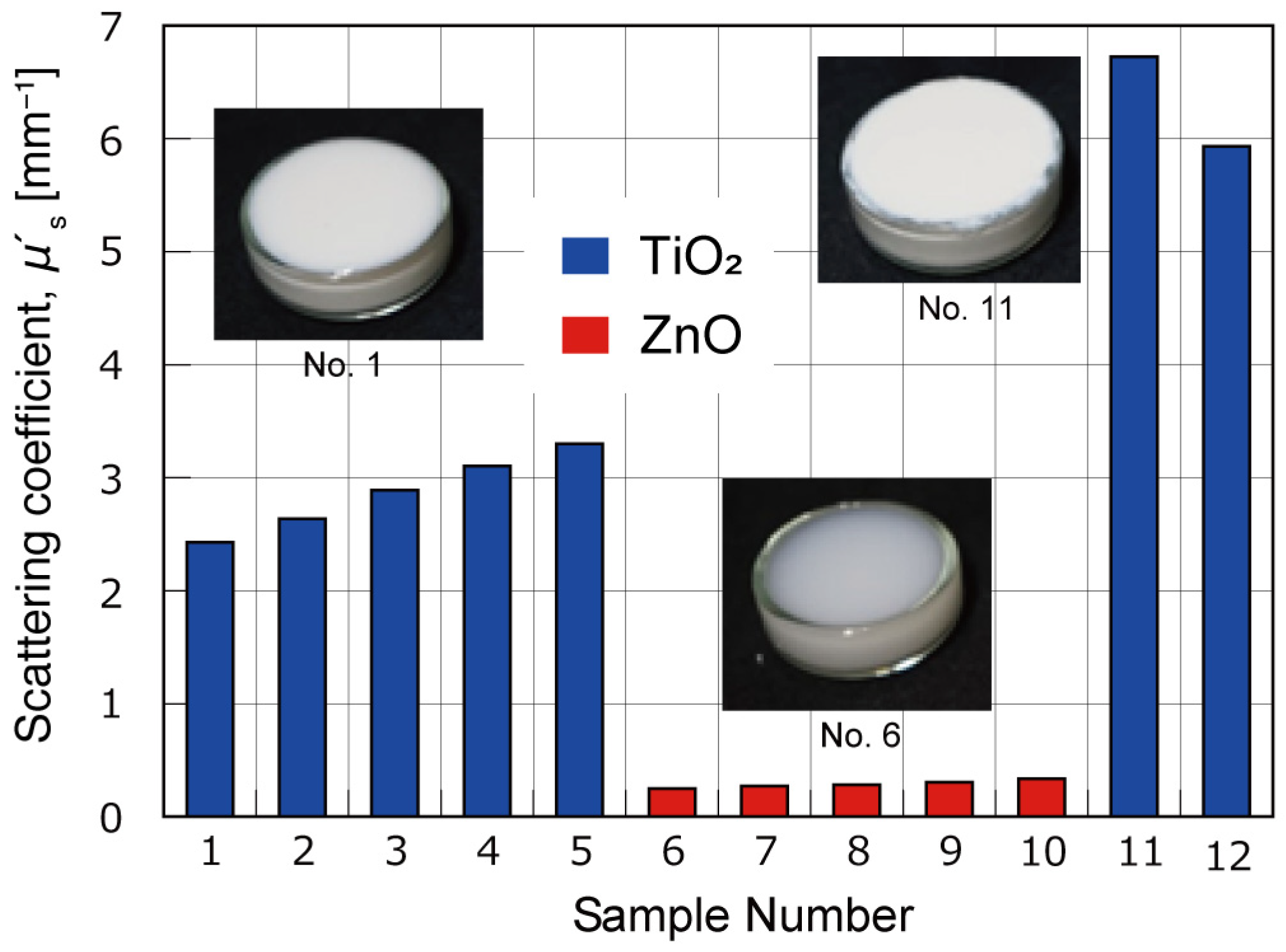
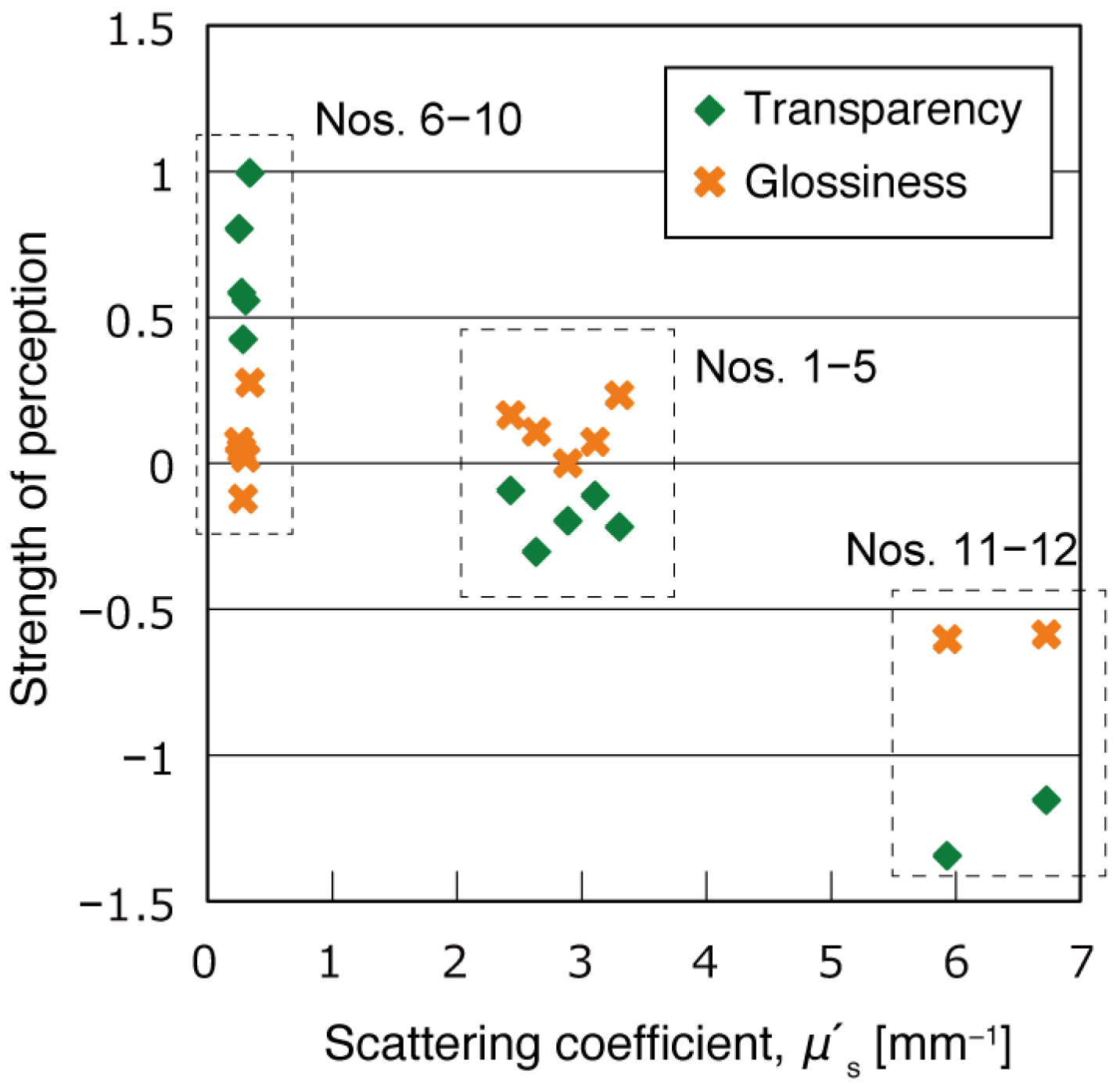
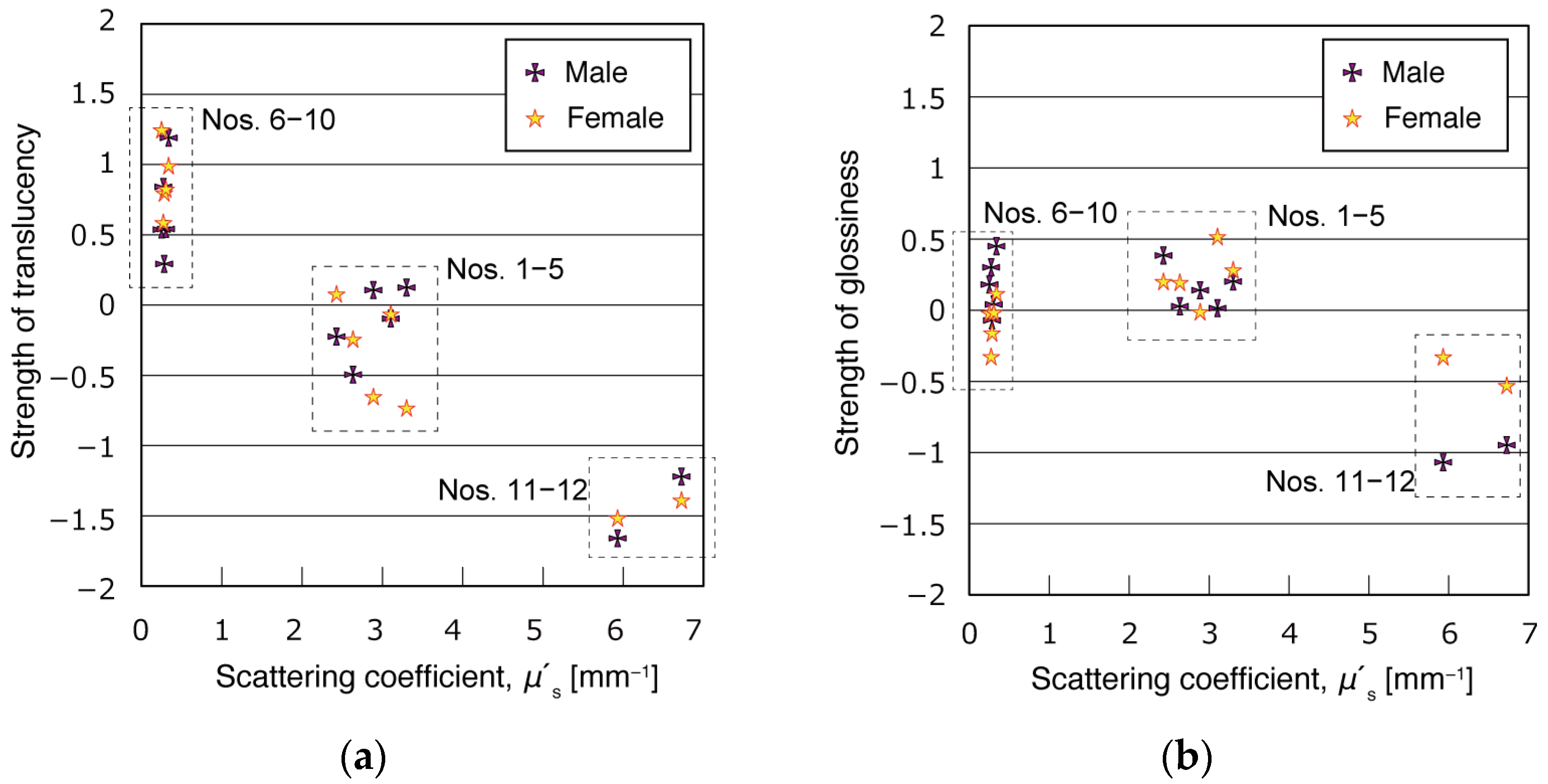
| Sample No. | 1 | 2 | 3 | 4 | 5 |
|---|---|---|---|---|---|
| Particle | TiO2 | TiO2 | TiO2 | TiO2 | TiO2 |
| Stirring speed [m/s] | 5 | 10 | 20 | 30 | 40 |
| Sample No. | 6 | 7 | 8 | 9 | 10 |
| Particle | ZnO | ZnO | ZnO | ZnO | ZnO |
| Stirring speed [m/s] | 5 | 10 | 20 | 30 | 40 |
| Material | Mass Concentration [wt%] |
|---|---|
| Purified water | 96.2 |
| Particle | 3.0 |
| Thickener, carboxymethyl cellulose | 0.8 |
| Sample No. | 11 | 12 |
|---|---|---|
| Stirring machine | Filmix-40 (FM-40) | Homogenizing Disper Model 2.5 (DH-2.5) |
| Stirring speed | 40 m/s | 3000 r/min |
| Stirring time [s] | 300 | 300 |
| Material | Mass Concentration [wt%] |
|---|---|
| Purified water | 8 |
| Particle (TiO2) | 30 |
| Thickener aqueous solution, carboxymethyl cellulose 2% | 50 |
| Emulsifier (HC-60) | 2 |
| Ethanol | 10 |
Publisher’s Note: MDPI stays neutral with regard to jurisdictional claims in published maps and institutional affiliations. |
© 2022 by the authors. Licensee MDPI, Basel, Switzerland. This article is an open access article distributed under the terms and conditions of the Creative Commons Attribution (CC BY) license (https://creativecommons.org/licenses/by/4.0/).
Share and Cite
Kono, T.; Konno, Y.; Kanayama, H.; Shimamura, K.; Rajagopalan, U.M.; Asano, C.; Takahashi, T.; Shundo, A.; Yamada, J. Perception of Translucency and Glossiness: Influence of the Optical Scattering Properties on Sensory Evaluation. Appl. Sci. 2022, 12, 8706. https://doi.org/10.3390/app12178706
Kono T, Konno Y, Kanayama H, Shimamura K, Rajagopalan UM, Asano C, Takahashi T, Shundo A, Yamada J. Perception of Translucency and Glossiness: Influence of the Optical Scattering Properties on Sensory Evaluation. Applied Sciences. 2022; 12(17):8706. https://doi.org/10.3390/app12178706
Chicago/Turabian StyleKono, Takahiro, Yusaku Konno, Hidekazu Kanayama, Kohei Shimamura, Uma Maheswari Rajagopalan, Chihiro Asano, Tadahito Takahashi, Akihito Shundo, and Jun Yamada. 2022. "Perception of Translucency and Glossiness: Influence of the Optical Scattering Properties on Sensory Evaluation" Applied Sciences 12, no. 17: 8706. https://doi.org/10.3390/app12178706
APA StyleKono, T., Konno, Y., Kanayama, H., Shimamura, K., Rajagopalan, U. M., Asano, C., Takahashi, T., Shundo, A., & Yamada, J. (2022). Perception of Translucency and Glossiness: Influence of the Optical Scattering Properties on Sensory Evaluation. Applied Sciences, 12(17), 8706. https://doi.org/10.3390/app12178706





